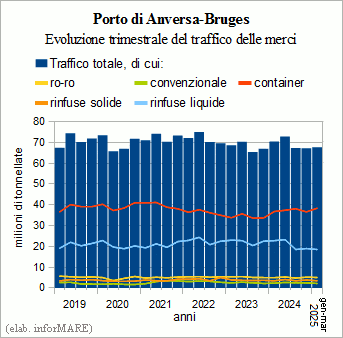
After four quarters of subdued growth, in the first three months
of 2025 freight traffic in the port system of
Antwerp-Bruges decreased by -4.0% over the same period
of last year, having fallen to 67.7 million tons. That
despite the +4.6% increase in containerized traffic which
amounted to 38.4 million tonnes and was
with a container handling of 3.4 million TEUs
(+4.6%), and the slight increase of +1.1% in rolling stock traffic

rose to 5.1 million tons. Freight traffic
was equal to 2.2 million tons
(-5,4%). The volume of dry bulk cargo, with 3.5 million
tonnes (-0.8%), was almost stable
while the decrease in liquid bulk cargo has been accentuated
amounted to 18.5 million tonnes (-19.1%), with a marked
- specified the Belgian Port Authority - in the volumes of
gasoline, naphtha and liquefied natural gas. The Port Authority has
specified that among the factors that contributed to this decline
changed market conditions in Africa, the reduction in
of the demand for naphtha by the petrochemical industry and the
EU sanctions on Russian LNG transhipments. The volume of products
chemicals, on the other hand, increased by +10.9%, mainly
thanks to a significant increase in biofuels (+128%). The institution
explained that without this impetus, the
would have recorded a slight decrease of -1.7% being
the European chemical industry under considerable pressure in
global competitiveness. Also in sharp decline was the
handling of new factory cars down by -9.6% to
about 800 thousand vehicles as a result of the difficult situation
of the European automotive industry.
On the occasion of today's presentation of statistical data on the
port traffic in the first quarter, the Port Authority of
Antwerp-Bruges also focused on the possible impact
on the traffic in the Belgian port of US import duties
announced by the administration led by Donald Trump, clarifying
which for now remains limited. Although some companies are
By bringing forward the duties - explained the Authority - so far there has been no
noted a clear acceleration in exports to the
United States. Container exports to the U.S. are
increased by +3.2%, steel recorded a temporary peak at
January and U.S. exports fell by
-20%, in line with the overall decline in exports of
Cars. At the same time - the body noted - factors
structural, such as the impact on transport planning
shipping in the liner container traffic segment,
Model changes in the automotive and suspension market
temporary production pressures, have increased pressure on
terminal. Therefore, although the immediate impact remains for now
- warned the Port Authority - it is clear that
Further developments in the area of tariffs in the coming months
commercial activities could have repercussions on the logistics chain.